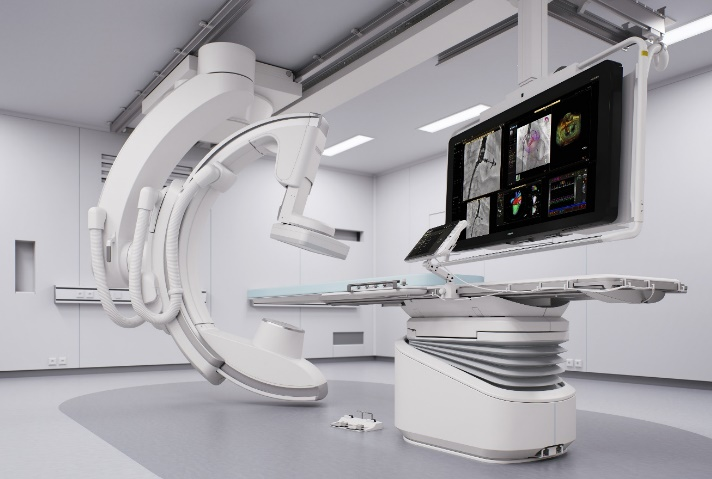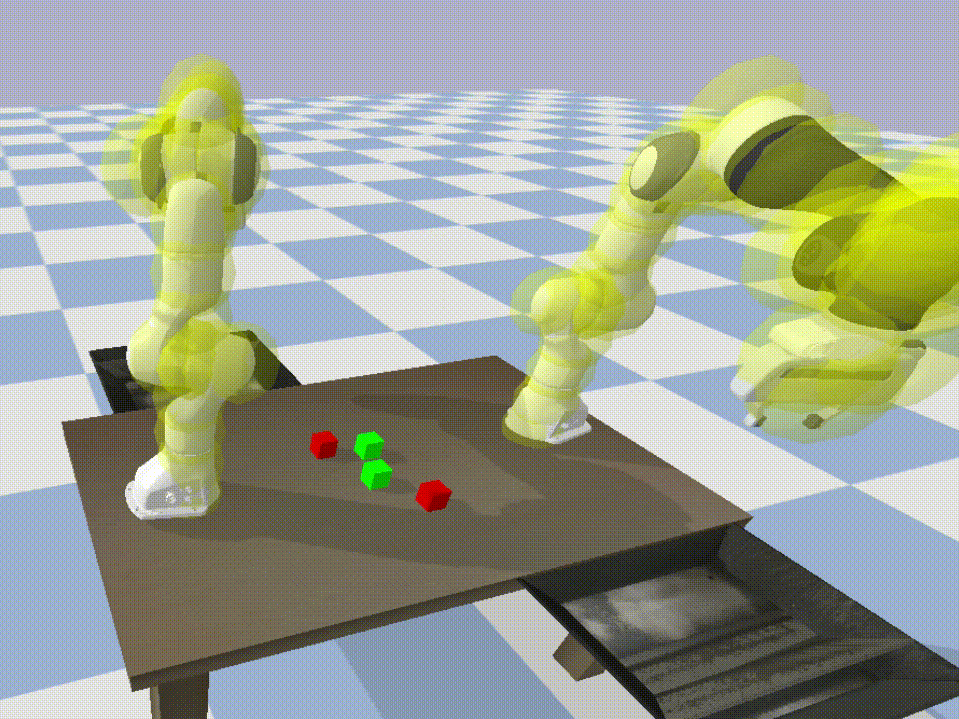Publications
2025
J2.
Globally-Guided Geometric Fabrics for Reactive Mobile Manipulation in Dynamic Environments
Tomas Merva*
,
Saray Bakker*
,
Max Spahn
,
Danning Zhao
,
Ivan Virgala
,
Javier Alonso-Mora
.
In RA-L,
2025.
In dynamic environments shared by humans and robots, mobile manipulators must continuously adapt to real-time changes to execute tasks successfully. While global planning methods are effective at considering the full task scope, they lack the computational efficiency required for reactive adaptation. In contrast, local planning approaches can be executed online but are limited by their inability to account for the full task's duration. To tackle this, we propose Globally-Guided Geometric Fabrics (G3F), a framework for real-time motion generation along the full task horizon, by interleaving an optimization-based planner with a fast reactive geometric motion planner, called geometric fabrics. The approach adapts the path and explores alternative target poses, while accounting for collision avoidance and the robot's physical constraints. This results in a real-time adaptive framework considering whole-body motions, where a robot operates in close proximity to other robots and humans. We validate our approach through various simulations and real-world experiments on mobile manipulators in multi-agent settings, achieving improved success rates compared to vanilla geometric fabrics, prioritized rollout fabrics and model predictive control.
J1.
Overcoming Explicit Environment Representations With Geometric Fabrics
Max Spahn
,
Saray Bakker
,
Javier Alonso-Mora
.
In RA-L,
2025.
Deployment of robots in dynamic environments requires reactive trajectory generation. While optimization-based methods, such as Model Predictive Control focus on constraint verificaction, Geometric Fabrics offer a computationally efficient way to generate trajectories that include all avoidance behaviors if the environment can be represented as a set of object primitives. Obtaining such a representation from sensor data is challenging, especially in dynamic environments. In this paper, we integrate implicit environment representations, such as Signed Distance Fields and Free Space Decomposition into the framework of Geometric Fabrics. In the process, we derive how numerical gradients can be integrated into the push and pull operations in Geometric Fabrics. Our experiments reveal that both, ground robots and robotic manipulators, can be controlled using these implicit representations. Moreover, we show that, unlike the explicit representation, implicit representations can be used in the presence of dynamic obstacles without further considerations. Finally, we demonstrate our methods in the real-world, showing the applicability of our approach in practice.
C4.
TamedPUMA: safe and stable imitation learning with geometric fabrics
Saray Bakker
,
Rodrigo Pérez-Dattari
,
Cosimo Della Santina
,
Wendelin Böhmer
,
Javier Alonso-Mora
.
In L4DC,
2025.
Using the language of dynamical systems, Imitation learning (IL) provides an intuitive and effective way of teaching stable task-space motions to robots with goal convergence. Yet, IL techniques are affected by serious limitations when it comes to ensuring safety and fulfillment of physical constraints. With this work, we solve this challenge via TamedPUMA, an IL algorithm augmented with a recent development in motion planning called geometric fabrics. As both the IL policy and geometric fabrics describe motions as artificial second-order dynamical systems, we propose two variations where IL provides a navigation policy for geometric fabrics. The result is a stable imita- tion learning strategy within which we can seamlessly blend geometrical constraints like collision avoidance and joint limits. Beyond providing a theoretical analysis, we demonstrate TamedPUMA with simulated and real-world tasks, including a 7-DoF manipulator.
C3.
Pushing Through Clutter With Movability Awareness of Blocking Obstacles
Joris J. Weeda
,
Saray Bakker
,
Gang Chen
,
Javier Alonso-Mora
.
In ICRA,
2025.
Navigation Among Movable Obstacles (NAMO) poses a challenge for traditional path-planning methods when obstacles block the path, requiring push actions to reach the goal. We propose a framework that enables movability- aware planning to overcome this challenge without relying on explicit obstacle placement. Our framework integrates a global Semantic Visibility Graph and a local Model Predictive Path Integral (SVG-MPPI) approach to efficiently sample rollouts, taking into account the continuous range of obstacle movability. A physics engine is adopted to simulate the interaction result of the rollouts with the environment, and generate trajectories that minimize contact force. In qualitative and quantitative experiments, SVG-MPPI outperforms the existing paradigm that uses only binary movability for planning, achieving higher success rates with reduced cumulative contact forces.
2024
C2.
A Bayesian optimization framework for the automatic tuning of MPC-based shared controllers
Anne van der Horst
,
Bas Meere
,
Dinesh Krishnamoorthy
,
Saray Bakker
,
Bram van de Vrande
,
Henry Stoutjesdijk
,
Marco Alonso
,
Elena Torta
.
In IEEE International Conference on Robotics and Automation (ICRA),
2024.
This paper presents a Bayesian optimization framework for the automatic tuning of shared controllers which are defined as a Model Predictive Control (MPC) problem. The proposed framework includes the design of performance metrics as well as the representation of user inputs for simulation-based optimization. The framework is applied to the optimization of a shared controller for an Image Guided Therapy robot. VR-based user experiments confirm the increase in performance of the automatically tuned MPC shared controller with respect to a hand-tuned baseline version as well as its generalization ability.
W2.
Safe and stable motion primitives via imitation learning and geometric fabrics
Saray Bakker
,
Rodrigo Pérez-Dattari
,
Cosimo Della Santina
,
Wendelin Böhmer
,
Javier Alonso-Mora
.
In CORL, Workshop on Mastering Robot Manipulation in a World of Abundant Data,
2024.
Using the language of dynamical systems, Imitation learning (IL) provides an intuitive and effective way of teaching stable task-space motions to robots with goal convergence. Yet, these techniques are affected by serious limitations when it comes to ensuring safety and fulfillment of physical constraints. With this work, we propose to solve this challenge via TamedPUMA, an IL algorithm augmented with a recent development in motion planning called geometric fabrics. We explore two variations of this approach, which we name the forcing policy method and the compatible potential method. The result is a stable imitation learning strategy within which we can seamlessly blend geometrical constraints like collision avoidance and joint limits. Beyond providing a theoretical analysis, we demonstrate TamedPUMA with simulated and real-world tasks, including a 7-DoF manipulator.
W1.
Reactive grasp and motion planning for adaptive mobile manipulation among obstacles
Tomas Merva
,
Saray Bakker
,
Max Spahn
,
Ivan Virgala
,
Javier Alonso-Mora
.
In Robotics: Science and Systems, Workshop on Frontiers of Optimization for Robotics,
2024.
Mobile manipulators are susceptible to situations in which the precomputed grasp pose is not reachable as the result of conflicts between collision avoidance behaviour and the manipulation task. In this work, we address this issue by combining real-time grasp planning with geometric motion planning for decentralized multi-agent systems, referred to as Reactive Grasp Fabrics (RGF). We optimize the precomputed grasp pose candidate to account for obstacles and the robot's kinematics. By leveraging a reactive geometric motion planner, specifically geometric fabrics, the grasp optimization problem can be simplified, resulting in a fast, adaptive framework that can resolve deadlock situations in pick-and-place tasks. We demonstrate the robustness of this approach by controlling a mobile manipulator in both simulation and real-world experiments in dynamic environments.
2023
C1.
Multi-Robot Local Motion Planning Using Dynamic Optimization Fabrics
Saray Bakker*
,
Luzia Knoedler*
,
Max Spahn
,
Wendelin Böhmer
,
Javier Alonso-Mora
.
In IEEE International Symposium on Multi-Robot & Multi-Agent Systems (MRS),
2023.
In this paper, we address the problem of real-time motion planning for multiple robotic manipulators that operate in close proximity. We build upon the concept of dynamic fabrics and extend them to multi-robot systems, referred to as Multi-Robot Dynamic Fabrics (MRDF). This geometric method enables a very high planning frequency for high-dimensional systems at the expense of being reactive and prone to deadlocks. To detect and resolve deadlocks, we propose Rollout Fabrics where MRDF are forward simulated in a decentralized manner. We validate the methods in simulated close-proximity pick-and-place scenarios with multiple manipulators, showing high-success rates and real-time performance.

